
Awesome-Graph-LLM
A collection of AWESOME things about Graph-Related LLMs.
Stars: 1995
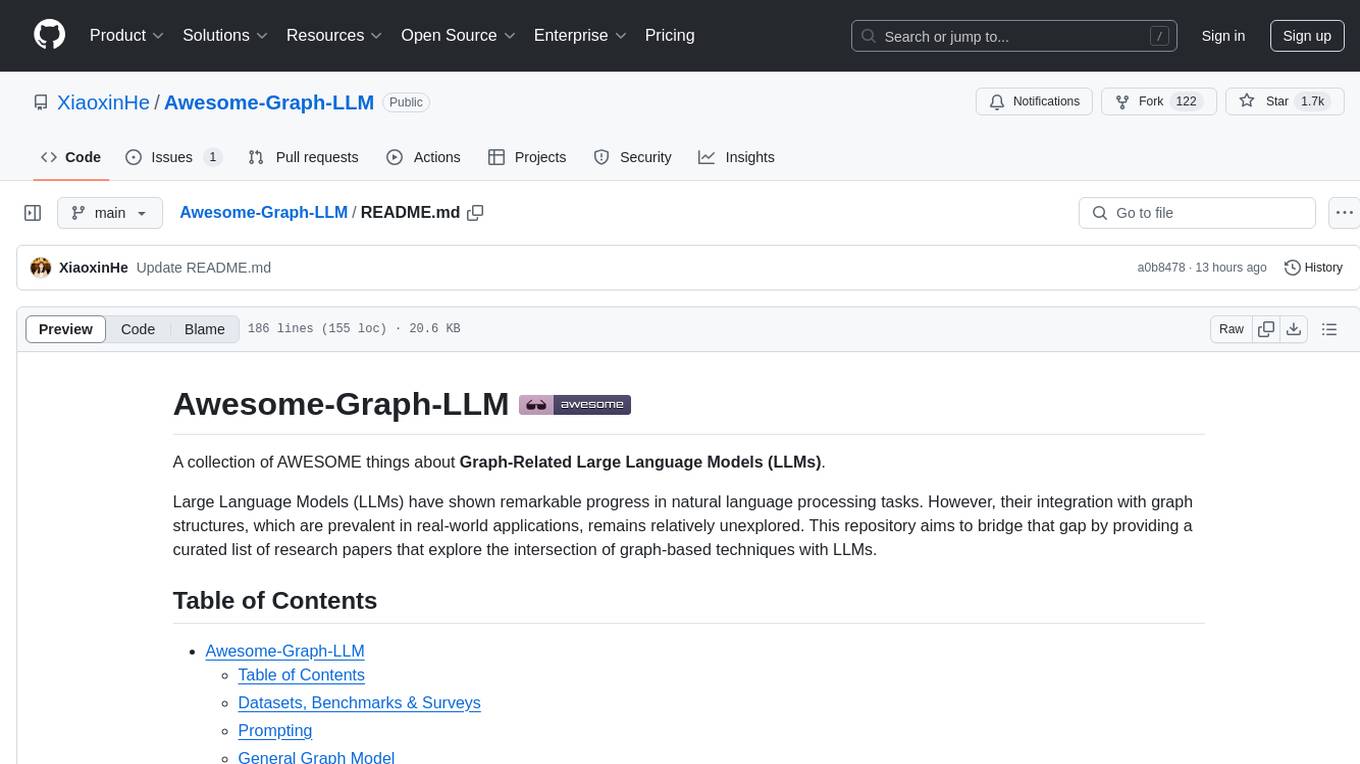
Awesome-Graph-LLM is a curated collection of research papers exploring the intersection of graph-based techniques with Large Language Models (LLMs). The repository aims to bridge the gap between LLMs and graph structures prevalent in real-world applications by providing a comprehensive list of papers covering various aspects of graph reasoning, node classification, graph classification/regression, knowledge graphs, multimodal models, applications, and tools. It serves as a valuable resource for researchers and practitioners interested in leveraging LLMs for graph-related tasks.
README:
A collection of AWESOME things about Graph-Related Large Language Models (LLMs).
Large Language Models (LLMs) have shown remarkable progress in natural language processing tasks. However, their integration with graph structures, which are prevalent in real-world applications, remains relatively unexplored. This repository aims to bridge that gap by providing a curated list of research papers that explore the intersection of graph-based techniques with LLMs.
- Awesome-Graph-LLM
- (NAACL'21) Knowledge Graph Based Synthetic Corpus Generation for Knowledge-Enhanced Language Model Pre-training [paper][code]
- (NeurIPS'23) Can Language Models Solve Graph Problems in Natural Language? [paper][code]
- (IEEE Intelligent Systems 2023) Integrating Graphs with Large Language Models: Methods and Prospects [paper]
- (ICLR'24) Talk like a Graph: Encoding Graphs for Large Language Models [paper]
- (NeurIPS'24) TEG-DB: A Comprehensive Dataset and Benchmark of Textual-Edge Graphs [pdf][code][datasets]
- (NAACL'24) Can Knowledge Graphs Reduce Hallucinations in LLMs? : A Survey [paper]
- (NeurIPS'24 D&B) Can Large Language Models Analyze Graphs like Professionals? A Benchmark, Datasets and Models [paper][code]
- (NeurIPS'24 D&B) GLBench: A Comprehensive Benchmark for Graph with Large Language Models [paper][code]
- (KDD'24) A Survey of Large Language Models for Graphs [paper][code]
- (IJCAI'24) A Survey of Graph Meets Large Language Model: Progress and Future Directions [paper][code]
- (TKDE'24) Large Language Models on Graphs: A Comprehensive Survey [paper][code]
- (arxiv 2023.05) GPT4Graph: Can Large Language Models Understand Graph Structured Data? An Empirical Evaluation and Benchmarking [paper]
- (arXiv 2023.08) Graph Meets LLMs: Towards Large Graph Models [paper]
- (arXiv 2023.10) Towards Graph Foundation Models: A Survey and Beyond [paper]
- (arXiv 2024.02) Towards Versatile Graph Learning Approach: from the Perspective of Large Language Models [paper]
- (arXiv 2024.04) Graph Machine Learning in the Era of Large Language Models (LLMs) [paper]
- (ICLR'25) How Do Large Language Models Understand Graph Patterns? A Benchmark for Graph Pattern Comprehension [paper]
- (arXiv 2024.10) GRS-QA - Graph Reasoning-Structured Question Answering Dataset [paper]
- (arXiv 2024.12) Large Language Models Meet Graph Neural Networks: A Perspective of Graph Mining [paper]
- (arxiv 2025.01) Graph2text or Graph2token: A Perspective of Large Language Models for Graph Learning [paper]
- (arXiv 2025.02) A Comprehensive Analysis on LLM-based Node Classification Algorithms [paper] [code] [project papge]
- (EMNLP'23) StructGPT: A General Framework for Large Language Model to Reason over Structured Data [paper][code]
- (ACL'24) Graph Chain-of-Thought: Augmenting Large Language Models by Reasoning on Graphs [paper][code]
- (AAAI'24) Graph of Thoughts: Solving Elaborate Problems with Large Language Models [paper][code]
- (arXiv 2023.05) PiVe: Prompting with Iterative Verification Improving Graph-based Generative Capability of LLMs [paper][code]
- (arXiv 2023.08) Boosting Logical Reasoning in Large Language Models through a New Framework: The Graph of Thought [paper]
- (arxiv 2023.10) Thought Propagation: An Analogical Approach to Complex Reasoning with Large Language Models [paper]
- (arxiv 2024.01) Topologies of Reasoning: Demystifying Chains, Trees, and Graphs of Thoughts [paper]
- (arXiv 2024.10) Can Graph Descriptive Order Affect Solving Graph Problems with LLMs? [paper]
- (ICLR'24) One for All: Towards Training One Graph Model for All Classification Tasks [paper][code]
- (ICML'24) LLaGA: Large Language and Graph Assistant [paper][code]
- (NeurIPS'24) LLMs as Zero-shot Graph Learners: Alignment of GNN Representations with LLM Token Embeddings [paper][code]
- (WWW'24) GraphTranslator: Aligning Graph Model to Large Language Model for Open-ended Tasks [paper][code]
- (KDD'24) HiGPT: Heterogeneous Graph Language Model [paper][code]
- (KDD'24) ZeroG: Investigating Cross-dataset Zero-shot Transferability in Graphs [paper][code]
- (SIGIR'24) GraphGPT: Graph Instruction Tuning for Large Language Models [paper][code][blog in Chinese]
- (ACL'24) InstructGraph: Boosting Large Language Models via Graph-centric Instruction Tuning and Preference Alignment [paper][code]
- (EACL'24') Natural Language is All a Graph Needs [paper][code]
- (KDD'25) UniGraph: Learning a Cross-Domain Graph Foundation Model From Natural Language [paper]
- (arXiv 2023.10) Graph Agent: Explicit Reasoning Agent for Graphs [paper]
- (arXiv 2024.02) Let Your Graph Do the Talking: Encoding Structured Data for LLMs [paper]
- (arXiv 2024.06) UniGLM: Training One Unified Language Model for Text-Attributed Graphs [paper][code]
- (arXiv 2024.07) GOFA: A Generative One-For-All Model for Joint Graph Language Modeling [paper][code]
- (arXiv 2024.08) AnyGraph: Graph Foundation Model in the Wild [paper][code]
- (arXiv 2024.10) NT-LLM: A Novel Node Tokenizer for Integrating Graph Structure into Large Language Models [paper]
- (NeurIPS'23) GraphAdapter: Tuning Vision-Language Models With Dual Knowledge Graph [paper][code]
- (NeurIPS'24) GITA: Graph to Visual and Textual Integration for Vision-Language Graph Reasoning [paper][code][project]
- (ACL 2024) Graph Language Models [paper][code]
- (arXiv 2023.10) Multimodal Graph Learning for Generative Tasks [paper][code]
- (KDD'24) GraphWiz: An Instruction-Following Language Model for Graph Problems [paper][code][project]
- (arXiv 2023.04) Graph-ToolFormer: To Empower LLMs with Graph Reasoning Ability via Prompt Augmented by ChatGPT [paper][code]
- (arXiv 2023.10) GraphText: Graph Reasoning in Text Space [paper]
- (arXiv 2023.10) GraphLLM: Boosting Graph Reasoning Ability of Large Language Model [paper][code]
- (arXiv 2024.10) GUNDAM: Aligning Large Language Models with Graph Understanding [paper]
- (arXiv 2024.10) Are Large-Language Models Graph Algorithmic Reasoners? [paper][code]
- (arXiv 2024.10) GCoder: Improving Large Language Model for Generalized Graph Problem Solving [paper] [code]
- (arXiv 2024.10) GraphTeam: Facilitating Large Language Model-based Graph Analysis via Multi-Agent Collaboration [paper] [code]
- (ICLR'25) GraphArena: Evaluating and Exploring Large Language Models on Graph Computation [paper] [code]
- (ICLR'24) Explanations as Features: LLM-Based Features for Text-Attributed Graphs [paper][code]
- (ICLR'24) Label-free Node Classification on Graphs with Large Language Models (LLMS) [paper]
- (WWW'24) Can GNN be Good Adapter for LLMs? [paper][code]
- (CIKM'24) Distilling Large Language Models for Text-Attributed Graph Learning [paper]
- (EMNLP'24) Let's Ask GNN: Empowering Large Language Model for Graph In-Context Learning [paper]
- (TMLR'24) Can LLMs Effectively Leverage Graph Structural Information through Prompts, and Why? [paper][code]
- (IJCAI'24) Efficient Tuning and Inference for Large Language Models on Textual Graphs [paper][code]
- (CIKM'24) Distilling Large Language Models for Text-Attributed Graph Learning [paper]
- (AAAI'25) Leveraging Large Language Models for Node Generation in Few-Shot Learning on Text-Attributed Graphs [paper]
- (WSDM'25) LOGIN: A Large Language Model Consulted Graph Neural Network Training Framework [paper][code]
- (arXiv 2023.07) Exploring the Potential of Large Language Models (LLMs) in Learning on Graphs [paper][code]
- (arXiv 2023.10) Disentangled Representation Learning with Large Language Models for Text-Attributed Graphs [paper]
- (arXiv 2023.11) Large Language Models as Topological Structure Enhancers for Text-Attributed Graphs [paper]
- (arXiv 2024.02) Similarity-based Neighbor Selection for Graph LLMs [paper][code]
- (arXiv 2024.02) GraphEdit: Large Language Models for Graph Structure Learning [paper][code]
- (arXiv 2024.06) GAugLLM: Improving Graph Contrastive Learning for Text-Attributed Graphs with Large Language Models [paper][code]
- (arXiv 2024.07) Enhancing Data-Limited Graph Neural Networks by Actively Distilling Knowledge from Large Language Models [paper]
- (arXiv 2024.07) All Against Some: Efficient Integration of Large Language Models for Message Passing in Graph Neural Networks [paper]
- (arXiv 2024.10) Let's Ask GNN: Empowering Large Language Model for Graph In-Context Learning [paper]
- (arXiv 2024.10) Large Language Model-based Augmentation for Imbalanced Node Classification on Text-Attributed Graphs [paper]
- (arXiv 2024.10) Enhance Graph Alignment for Large Language Models [paper]
- (arXiv 2025.01) Each Graph is a New Language: Graph Learning with LLMs [paper]
- (arXiv 2025.02) A Comprehensive Analysis on LLM-based Node Classification Algorithms [paper][code] [project papge]
- (AAAI'22) Enhanced Story Comprehension for Large Language Models through Dynamic Document-Based Knowledge Graphs [paper]
- (EMNLP'22) Language Models of Code are Few-Shot Commonsense Learners [paper][code]
- (SIGIR'23) Schema-aware Reference as Prompt Improves Data-Efficient Knowledge Graph Construction [paper][code]
- (TKDE‘23) AutoAlign: Fully Automatic and Effective Knowledge Graph Alignment enabled by Large Language Models [paper][code]
- (ICLR'24) Think-on-Graph: Deep and Responsible Reasoning of Large Language Model on Knowledge Graph [paper][code]
- (ICLR‘24) Reasoning on Graphs: Faithful and Interpretable Large Language Model Reasoning [paper][code]
- (AAAI'24) Graph Neural Prompting with Large Language Models [paper][code]
- (EMNLP'24) Extract, Define, Canonicalize: An LLM-based Framework for Knowledge Graph Construction [paper][code]
- (EMNLP'24) LLM-Based Multi-Hop Question Answering with Knowledge Graph Integration in Evolving Environments [paper]
- (ACL'24) Graph Language Models [paper][code]
- (ACL'24) Large Language Models Can Learn Temporal Reasoning [paper][code]
- (ACL'24) Call Me When Necessary: LLMs can Efficiently and Faithfully Reason over Structured Environments [paper][code]
- (ACL'24) MindMap: Knowledge Graph Prompting Sparks Graph of Thoughts in Large Language Models [paper][code]
- (NAACL'24) zrLLM: Zero-Shot Relational Learning on Temporal Knowledge Graphs with Large Language Models[paper]
- (arXiv 2023.04) CodeKGC: Code Language Model for Generative Knowledge Graph Construction [paper][code]
- (arXiv 2023.05) Knowledge Graph Completion Models are Few-shot Learners: An Empirical Study of Relation Labeling in E-commerce with LLMs [paper]
- (arXiv 2023.10) Faithful Path Language Modelling for Explainable Recommendation over Knowledge Graph [paper]
- (arXiv 2023.12) KGLens: A Parameterized Knowledge Graph Solution to Assess What an LLM Does and Doesn’t Know [paper]
- (arXiv 2024.02) Large Language Model Meets Graph Neural Network in Knowledge Distillation [paper]
- (arXiv 2024.02) Knowledge Graph Large Language Model (KG-LLM) for Link Prediction [paper]
- (arXiv 2024.04) Evaluating the Factuality of Large Language Models using Large-Scale Knowledge Graphs [paper][code]
- (arXiv 2024.05) FiDeLiS: Faithful Reasoning in Large Language Model for Knowledge Graph Question Answering [paper]
- (arXiv 2024.06) Explore then Determine: A GNN-LLM Synergy Framework for Reasoning over Knowledge Graph [paper]
- (arXiv 2024.11) Synergizing LLM Agents and Knowledge Graph for Socioeconomic Prediction in LBSN [paper]
- (arXiv 2025.01) Fast Think-on-Graph: Wider, Deeper and Faster Reasoning of Large Language Model on Knowledge Graph [paper][code]
- (NeurIPS'23) GIMLET: A Unified Graph-Text Model for Instruction-Based Molecule Zero-Shot Learning [paper][code]
- (arXiv 2023.07) Can Large Language Models Empower Molecular Property Prediction? [paper][code]
- (arXiv 2024.06) MolecularGPT: Open Large Language Model (LLM) for Few-Shot Molecular Property Prediction [paper][code]
- (arXiv 2024.06) HIGHT: Hierarchical Graph Tokenization for Graph-Language Alignment [paper][project]
- (arXiv 2024.06) MolX: Enhancing Large Language Models for Molecular Learning with A Multi-Modal Extension [paper]
- (arXiv 2024.06) LLM and GNN are Complementary: Distilling LLM for Multimodal Graph Learning [paper]
- (arXiv 2024.10) G2T-LLM: Graph-to-Tree Text Encoding for Molecule Generation with Fine-Tuned Large Language Models [paper]
- (NeurIPS'24) G-Retriever: Retrieval-Augmented Generation for Textual Graph Understanding and Question Answering [paper][code][blog]
- (NeurIPS'24) HippoRAG: Neurobiologically Inspired Long-Term Memory for Large Language Models [paper][code]
- (arxiv 2024.04) From Local to Global: A Graph RAG Approach to Query-Focused Summarization [paper]
- (arXiv 2024.05) Don't Forget to Connect! Improving RAG with Graph-based Reranking [paper]
- (arXiv 2024.06) GNN-RAG: Graph Neural Retrieval for Large Language Modeling Reasoning [paper][code]
- (arXiv 2024.10) Graph of Records: Boosting Retrieval Augmented Generation for Long-context Summarization with Graphs [paper] [code]
- (arXiv 2025.01) Retrieval-Augmented Generation with Graphs (GraphRAG) [paper][code]
- (WWW'25) G-Refer: Graph Retrieval-Augmented Large Language Model for Explainable Recommendation [paper]
- (arXiv 2025.02) GFM-RAG: Graph Foundation Model for Retrieval Augmented Generation [paper] [code]
- (NeurIPS'24) Can Graph Learning Improve Planning in LLM-based Agents? [paper][code]
- (ICML'24) Graph-enhanced Large Language Models in Asynchronous Plan Reasoning [paper][code]
- (ICLR'25) Benchmarking Agentic Workflow Generation [paper] [code]
- (ICML'24) GPTSwarm: Language Agents as Optimizable Graphs [paper] [code]
- (ICLR'25) Scaling Large-Language-Model-based Multi-Agent Collaboration [paper] [code]
- (ICLR'25) Cut the Crap: An Economical Communication Pipeline for LLM-based Multi-Agent Systems [paper] [code]
- (arXiv 2024.10) G-Designer: Architecting Multi-agent Communication Topologies via Graph Neural Networks [paper] [code]
- (arXiv 2025.02) EvoFlow: Evolving Diverse Agentic Workflows On The Fly [paper]
- (NeurIPS'24) Intruding with Words: Towards Understanding Graph Injection Attacks at the Text Level [paper]
- (KDD'25) Can Large Language Models Improve the Adversarial Robustness of Graph Neural Networks? [paper][code]
- (arXiv 2024.07) Learning on Graphs with Large Language Models(LLMs): A Deep Dive into Model Robustness [paper][code]
- (NeurIPS'24) Microstructures and Accuracy of Graph Recall by Large Language Models [paper][code]
- (WSDM'24) LLMRec: Large Language Models with Graph Augmentation for Recommendation [paper][code][blog in Chinese]
- (KDD'24) LLM4DyG: Can Large Language Models Solve Problems on Dynamic Graphs? [paper][code]
- (Complex Networks 2024) LLMs hallucinate graphs too: a structural perspective [paper]
- (AAAI'25) Bootstrapping Heterogeneous Graph Representation Learning via Large Language Models: A Generalized Approach [paper]
- (arXiv 2023.03) Ask and You Shall Receive (a Graph Drawing): Testing ChatGPT’s Potential to Apply Graph Layout Algorithms [paper]
- (arXiv 2023.05) Graph Meets LLM: A Novel Approach to Collaborative Filtering for Robust Conversational Understanding [paper]
- (arXiv 2023.05) ChatGPT Informed Graph Neural Network for Stock Movement Prediction [paper][code]
- (arXiv 2023.10) Graph Neural Architecture Search with GPT-4 [paper]
- (arXiv 2023.11) Biomedical knowledge graph-enhanced prompt generation for large language models [paper][code]
- (arXiv 2023.11) Graph-Guided Reasoning for Multi-Hop Question Answering in Large Language Models [paper]
- (arXiv 2024.02) Causal Graph Discovery with Retrieval-Augmented Generation based Large Language Models [paper]
- (arXiv 2024.02) Efficient Causal Graph Discovery Using Large Language Models [paper]
- (arXiv 2024.03) Exploring the Potential of Large Language Models in Graph Generation [paper]
- (arXiv 2024.07) LLMExplainer: Large Language Model based Bayesian Inference for Graph Explanation Generation [paper]
- (arXiv 2024.08) CodexGraph: Bridging Large Language Models and Code Repositories via Code Graph Databases [paper][code][project]
- (arXiv 2024.10) Graph Linearization Methods for Reasoning on Graphs with Large Language Models [paper]
- (arXiv 2024.10) GraphRouter: A Graph-based Router for LLM Selections [paper][code]
- (ICLR'25) RepoGraph: Enhancing AI Software Engineering with Repository-level Code Graph [paper] [code]
- GraphGPT: Extrapolating knowledge graphs from unstructured text using GPT-3
- GraphML: Graph markup language. An XML-based file format for graphs.
- GML: Graph modelling language. Read graphs in GML format.
- PyG: GNNs + LLMs: Examples for Co-training LLMs and GNNs
👍 Contributions to this repository are welcome!
If you have come across relevant resources, feel free to open an issue or submit a pull request.
- (*conference|journal*) paper_name [[pdf](link)][[code](link)]
For Tasks:
Click tags to check more tools for each tasksFor Jobs:
Alternative AI tools for Awesome-Graph-LLM
Similar Open Source Tools

Awesome-Graph-LLM
Awesome-Graph-LLM is a curated collection of research papers exploring the intersection of graph-based techniques with Large Language Models (LLMs). The repository aims to bridge the gap between LLMs and graph structures prevalent in real-world applications by providing a comprehensive list of papers covering various aspects of graph reasoning, node classification, graph classification/regression, knowledge graphs, multimodal models, applications, and tools. It serves as a valuable resource for researchers and practitioners interested in leveraging LLMs for graph-related tasks.
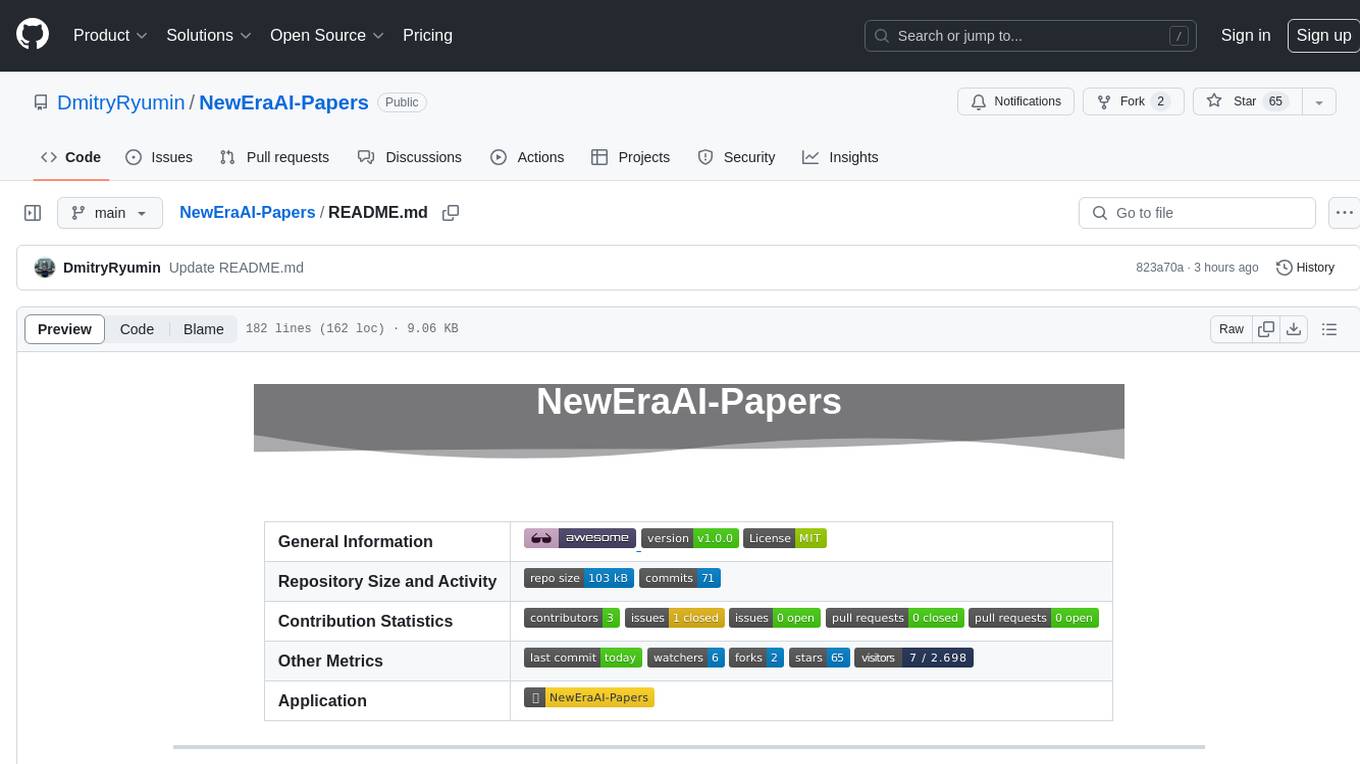
NewEraAI-Papers
The NewEraAI-Papers repository provides links to collections of influential and interesting research papers from top AI conferences, along with open-source code to promote reproducibility and provide detailed implementation insights beyond the scope of the article. Users can stay up to date with the latest advances in AI research by exploring this repository. Contributions to improve the completeness of the list are welcomed, and users can create pull requests, open issues, or contact the repository owner via email to enhance the repository further.
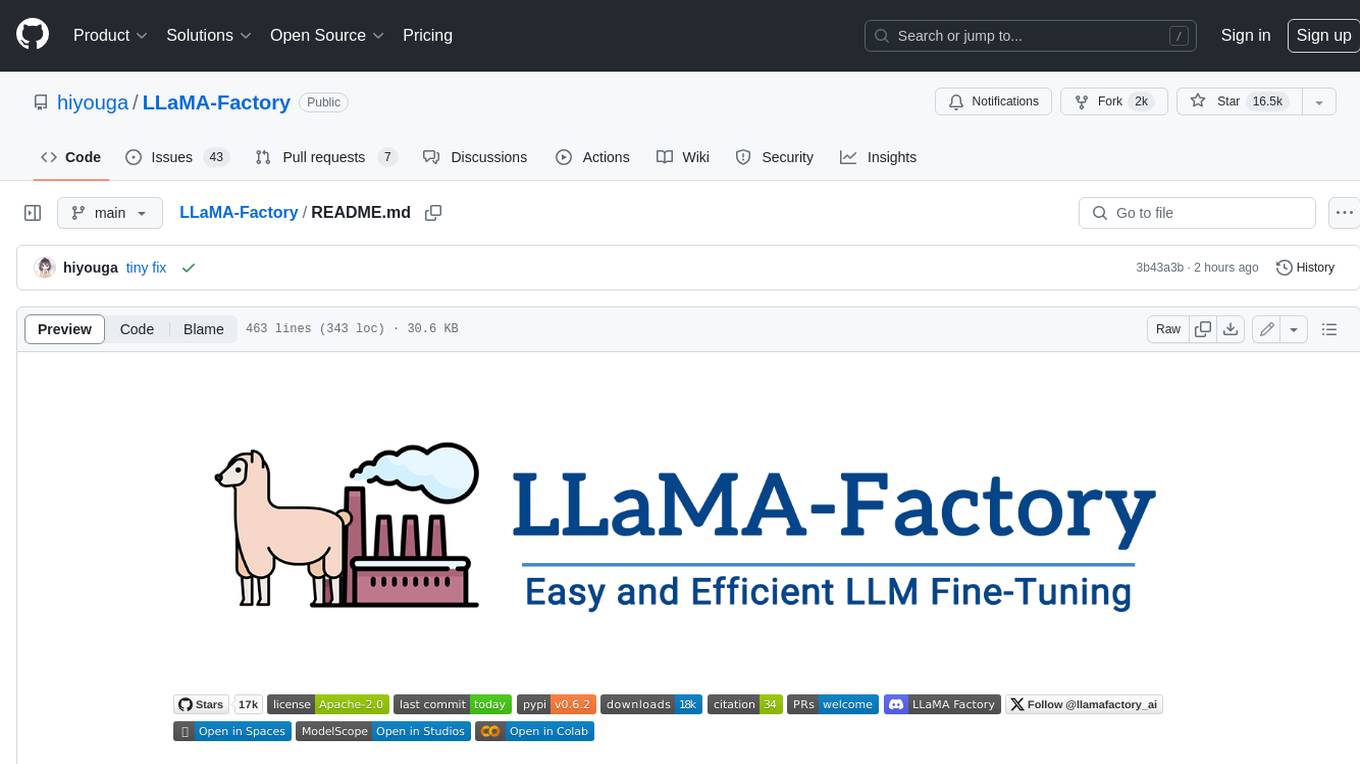
LLaMA-Factory
LLaMA Factory is a unified framework for fine-tuning 100+ large language models (LLMs) with various methods, including pre-training, supervised fine-tuning, reward modeling, PPO, DPO and ORPO. It features integrated algorithms like GaLore, BAdam, DoRA, LongLoRA, LLaMA Pro, LoRA+, LoftQ and Agent tuning, as well as practical tricks like FlashAttention-2, Unsloth, RoPE scaling, NEFTune and rsLoRA. LLaMA Factory provides experiment monitors like LlamaBoard, TensorBoard, Wandb, MLflow, etc., and supports faster inference with OpenAI-style API, Gradio UI and CLI with vLLM worker. Compared to ChatGLM's P-Tuning, LLaMA Factory's LoRA tuning offers up to 3.7 times faster training speed with a better Rouge score on the advertising text generation task. By leveraging 4-bit quantization technique, LLaMA Factory's QLoRA further improves the efficiency regarding the GPU memory.
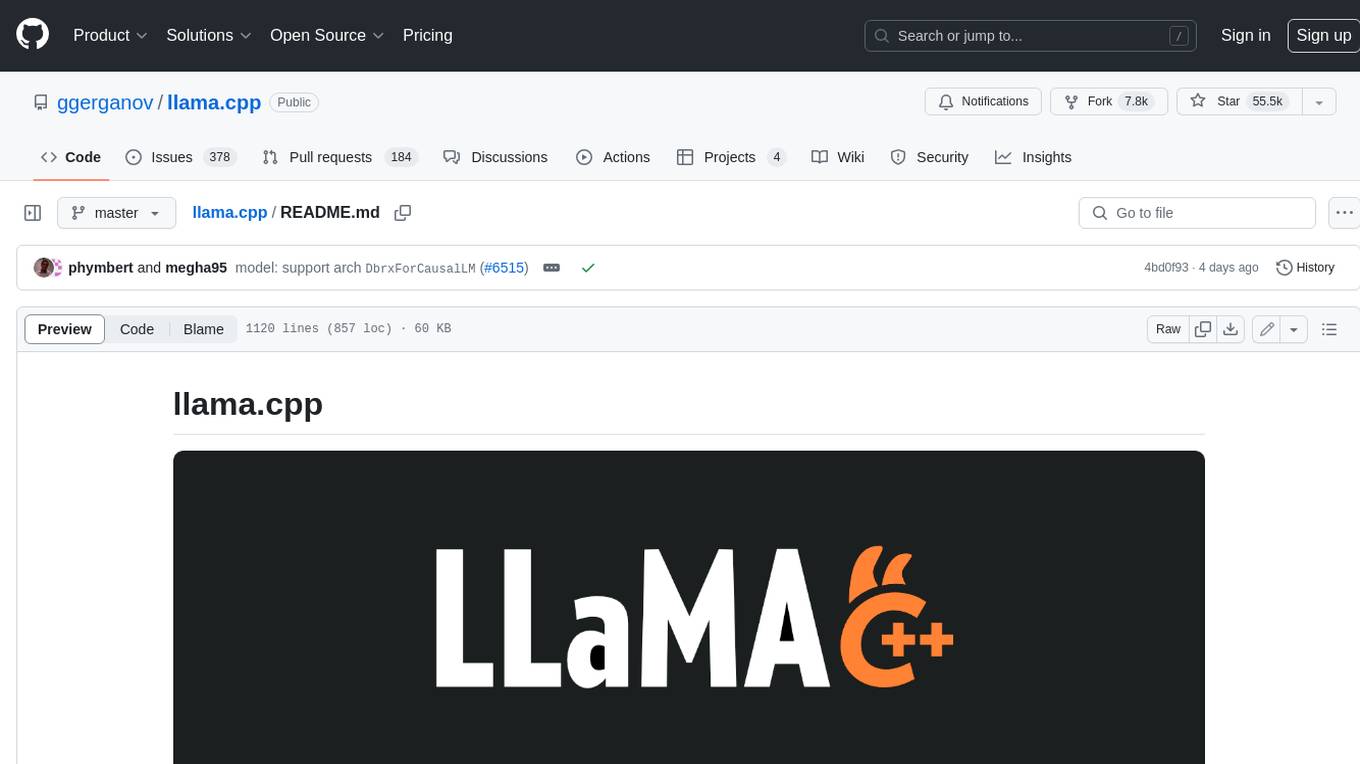
llama.cpp
llama.cpp is a C++ implementation of LLaMA, a large language model from Meta. It provides a command-line interface for inference and can be used for a variety of tasks, including text generation, translation, and question answering. llama.cpp is highly optimized for performance and can be run on a variety of hardware, including CPUs, GPUs, and TPUs.
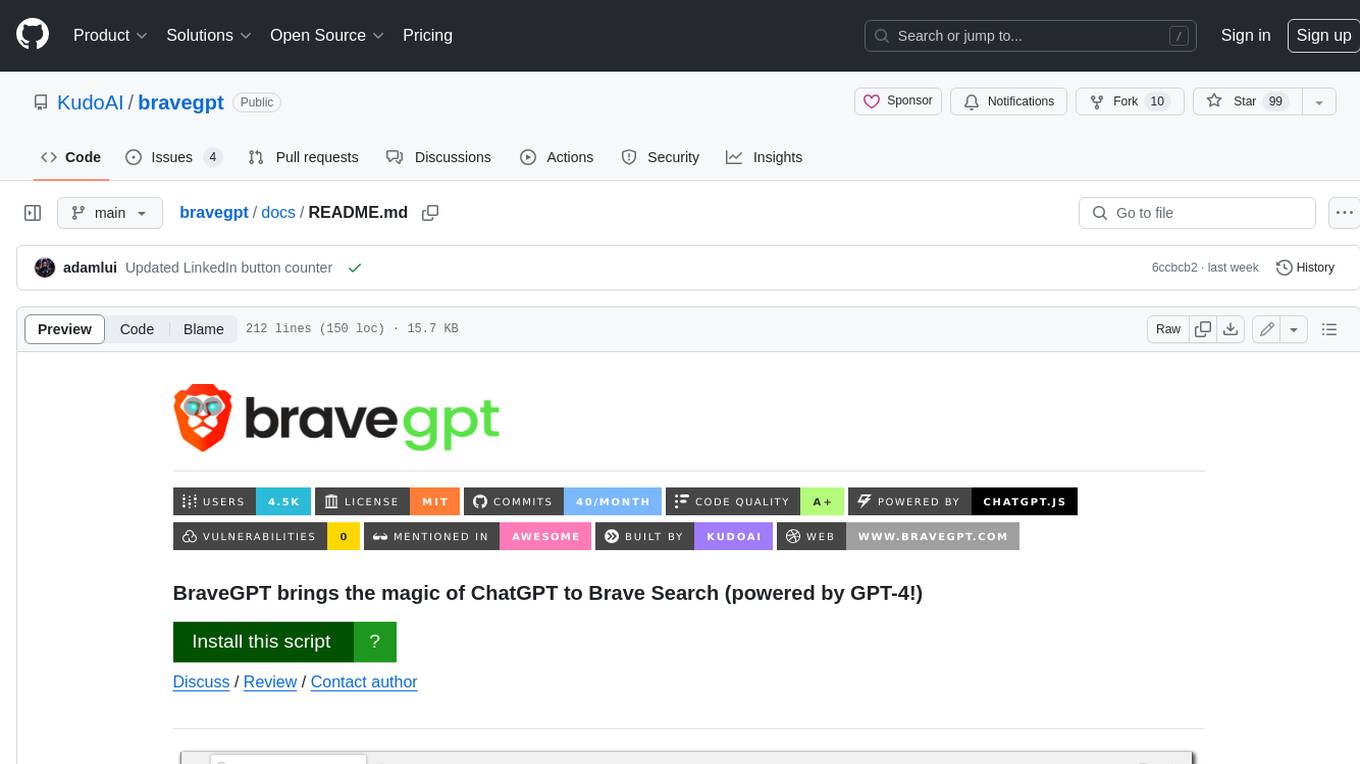
bravegpt
BraveGPT is a userscript that brings the power of ChatGPT to Brave Search. It allows users to engage with a conversational AI assistant directly within their search results, providing instant and personalized responses to their queries. BraveGPT is powered by GPT-4, the latest and most advanced language model from OpenAI, ensuring accurate and comprehensive answers. With BraveGPT, users can ask questions, get summaries, generate creative content, and more, all without leaving the Brave Search interface. The tool is easy to install and use, making it accessible to users of all levels. BraveGPT is a valuable addition to the Brave Search experience, enhancing its capabilities and providing users with a more efficient and informative search experience.
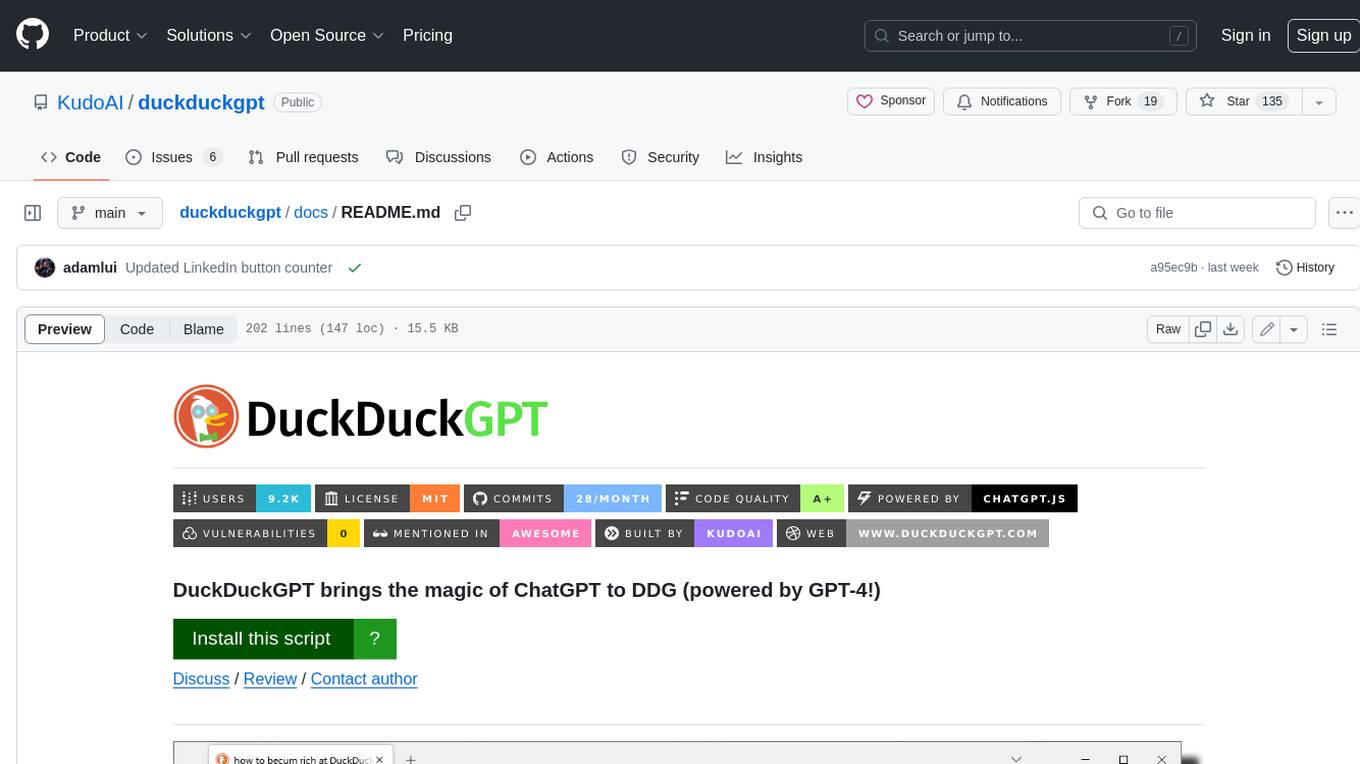
duckduckgpt
DuckDuckGPT brings the magic of ChatGPT to DDG (powered by GPT-4!). DuckDuckGPT is a browser extension that allows you to use ChatGPT within DuckDuckGo. This means you can ask ChatGPT questions, get help with tasks, and generate creative content, all without leaving DuckDuckGo. DuckDuckGPT is easy to use. Once you have installed the extension, simply type your question into the DuckDuckGo search bar and hit enter. ChatGPT will then generate a response that will appear below the search results. DuckDuckGPT is a powerful tool that can help you with a wide variety of tasks. Here are just a few examples of what you can use it for: * Get help with research * Write essays and other creative content * Translate languages * Get coding help * Answer trivia questions * And much more! DuckDuckGPT is still in development, but it is already a very powerful tool. As GPT-4 continues to improve, DuckDuckGPT will only get better. So if you are looking for a way to make your DuckDuckGo searches more productive, be sure to give DuckDuckGPT a try.
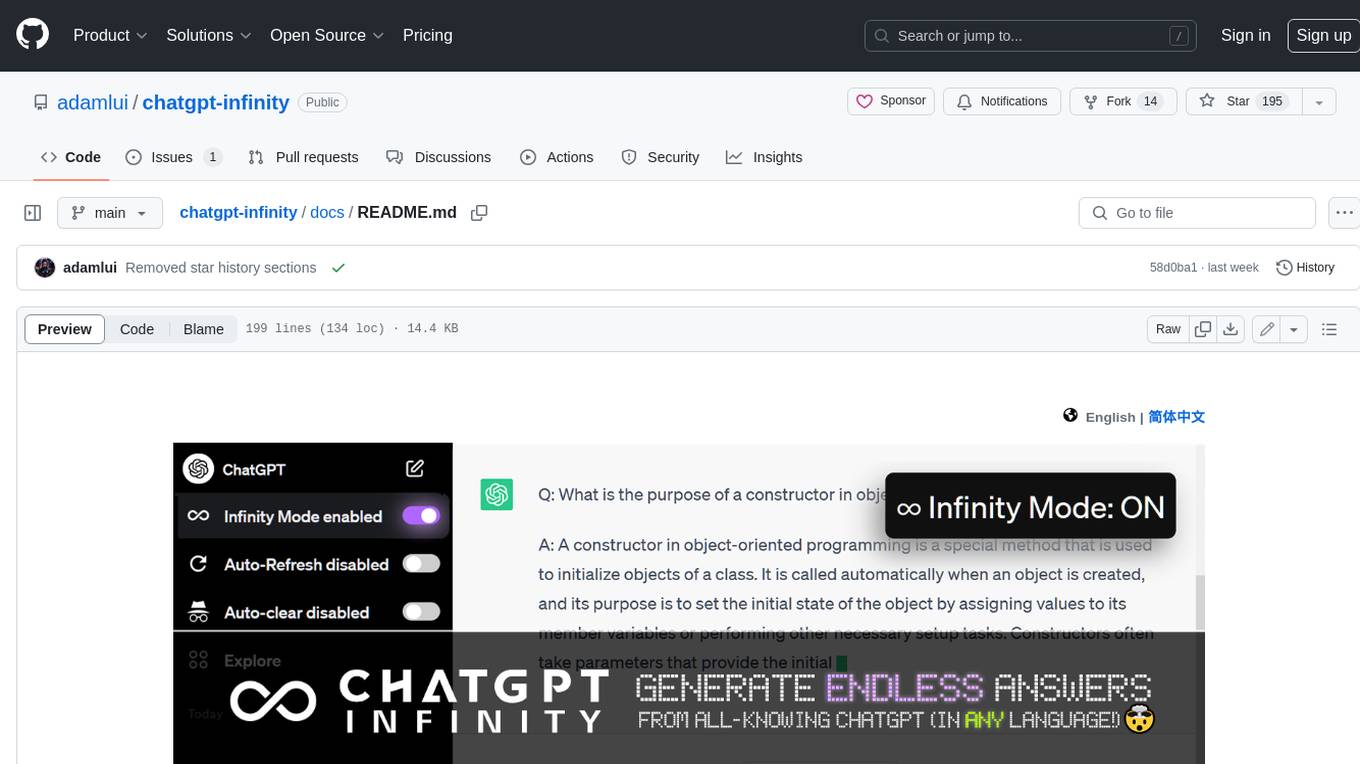
chatgpt-infinity
ChatGPT Infinity is a free and powerful add-on that makes ChatGPT generate infinite answers on any topic. It offers customizable topic selection, multilingual support, adjustable response interval, and auto-scroll feature for a seamless chat experience.
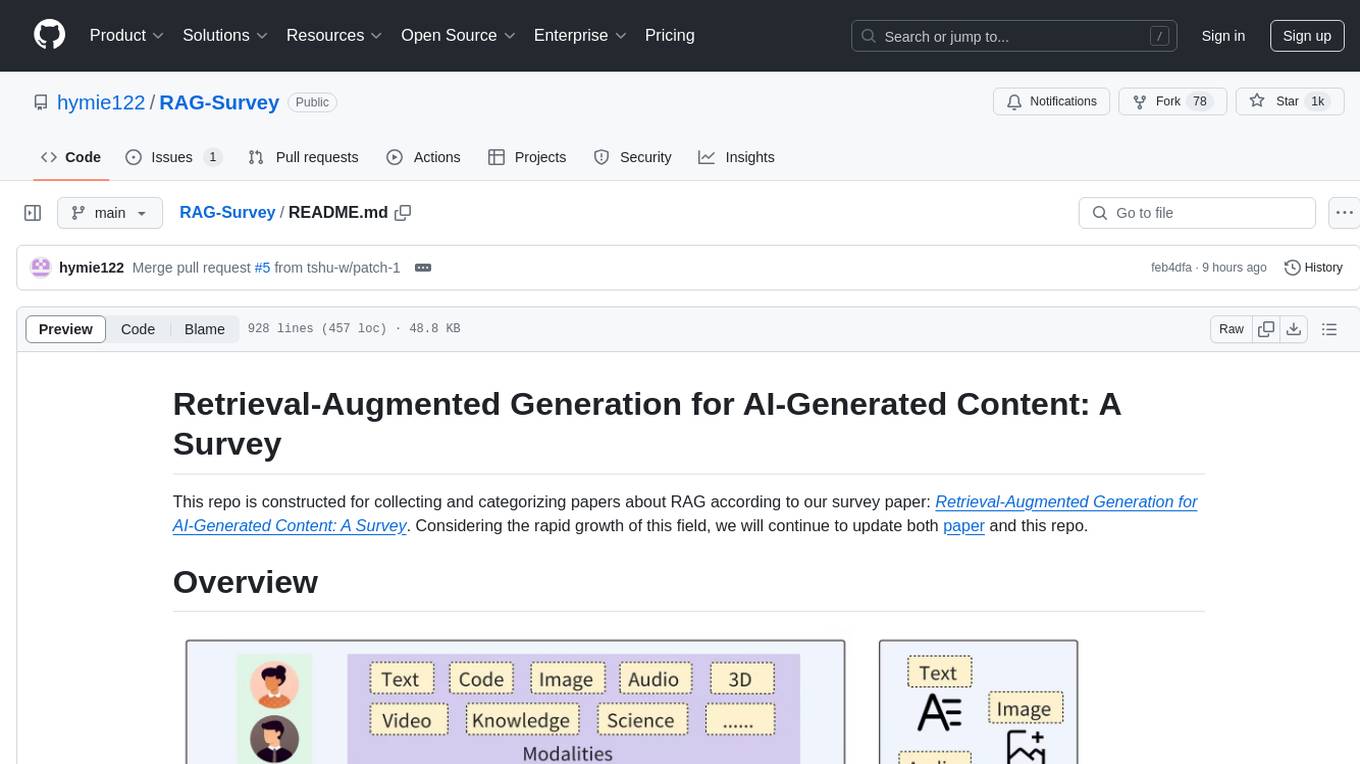
RAG-Survey
This repository is dedicated to collecting and categorizing papers related to Retrieval-Augmented Generation (RAG) for AI-generated content. It serves as a survey repository based on the paper 'Retrieval-Augmented Generation for AI-Generated Content: A Survey'. The repository is continuously updated to keep up with the rapid growth in the field of RAG.

intel-extension-for-transformers
Intel® Extension for Transformers is an innovative toolkit designed to accelerate GenAI/LLM everywhere with the optimal performance of Transformer-based models on various Intel platforms, including Intel Gaudi2, Intel CPU, and Intel GPU. The toolkit provides the below key features and examples: * Seamless user experience of model compressions on Transformer-based models by extending [Hugging Face transformers](https://github.com/huggingface/transformers) APIs and leveraging [Intel® Neural Compressor](https://github.com/intel/neural-compressor) * Advanced software optimizations and unique compression-aware runtime (released with NeurIPS 2022's paper [Fast Distilbert on CPUs](https://arxiv.org/abs/2211.07715) and [QuaLA-MiniLM: a Quantized Length Adaptive MiniLM](https://arxiv.org/abs/2210.17114), and NeurIPS 2021's paper [Prune Once for All: Sparse Pre-Trained Language Models](https://arxiv.org/abs/2111.05754)) * Optimized Transformer-based model packages such as [Stable Diffusion](examples/huggingface/pytorch/text-to-image/deployment/stable_diffusion), [GPT-J-6B](examples/huggingface/pytorch/text-generation/deployment), [GPT-NEOX](examples/huggingface/pytorch/language-modeling/quantization#2-validated-model-list), [BLOOM-176B](examples/huggingface/pytorch/language-modeling/inference#BLOOM-176B), [T5](examples/huggingface/pytorch/summarization/quantization#2-validated-model-list), [Flan-T5](examples/huggingface/pytorch/summarization/quantization#2-validated-model-list), and end-to-end workflows such as [SetFit-based text classification](docs/tutorials/pytorch/text-classification/SetFit_model_compression_AGNews.ipynb) and [document level sentiment analysis (DLSA)](workflows/dlsa) * [NeuralChat](intel_extension_for_transformers/neural_chat), a customizable chatbot framework to create your own chatbot within minutes by leveraging a rich set of [plugins](https://github.com/intel/intel-extension-for-transformers/blob/main/intel_extension_for_transformers/neural_chat/docs/advanced_features.md) such as [Knowledge Retrieval](./intel_extension_for_transformers/neural_chat/pipeline/plugins/retrieval/README.md), [Speech Interaction](./intel_extension_for_transformers/neural_chat/pipeline/plugins/audio/README.md), [Query Caching](./intel_extension_for_transformers/neural_chat/pipeline/plugins/caching/README.md), and [Security Guardrail](./intel_extension_for_transformers/neural_chat/pipeline/plugins/security/README.md). This framework supports Intel Gaudi2/CPU/GPU. * [Inference](https://github.com/intel/neural-speed/tree/main) of Large Language Model (LLM) in pure C/C++ with weight-only quantization kernels for Intel CPU and Intel GPU (TBD), supporting [GPT-NEOX](https://github.com/intel/neural-speed/tree/main/neural_speed/models/gptneox), [LLAMA](https://github.com/intel/neural-speed/tree/main/neural_speed/models/llama), [MPT](https://github.com/intel/neural-speed/tree/main/neural_speed/models/mpt), [FALCON](https://github.com/intel/neural-speed/tree/main/neural_speed/models/falcon), [BLOOM-7B](https://github.com/intel/neural-speed/tree/main/neural_speed/models/bloom), [OPT](https://github.com/intel/neural-speed/tree/main/neural_speed/models/opt), [ChatGLM2-6B](https://github.com/intel/neural-speed/tree/main/neural_speed/models/chatglm), [GPT-J-6B](https://github.com/intel/neural-speed/tree/main/neural_speed/models/gptj), and [Dolly-v2-3B](https://github.com/intel/neural-speed/tree/main/neural_speed/models/gptneox). Support AMX, VNNI, AVX512F and AVX2 instruction set. We've boosted the performance of Intel CPUs, with a particular focus on the 4th generation Intel Xeon Scalable processor, codenamed [Sapphire Rapids](https://www.intel.com/content/www/us/en/products/docs/processors/xeon-accelerated/4th-gen-xeon-scalable-processors.html).
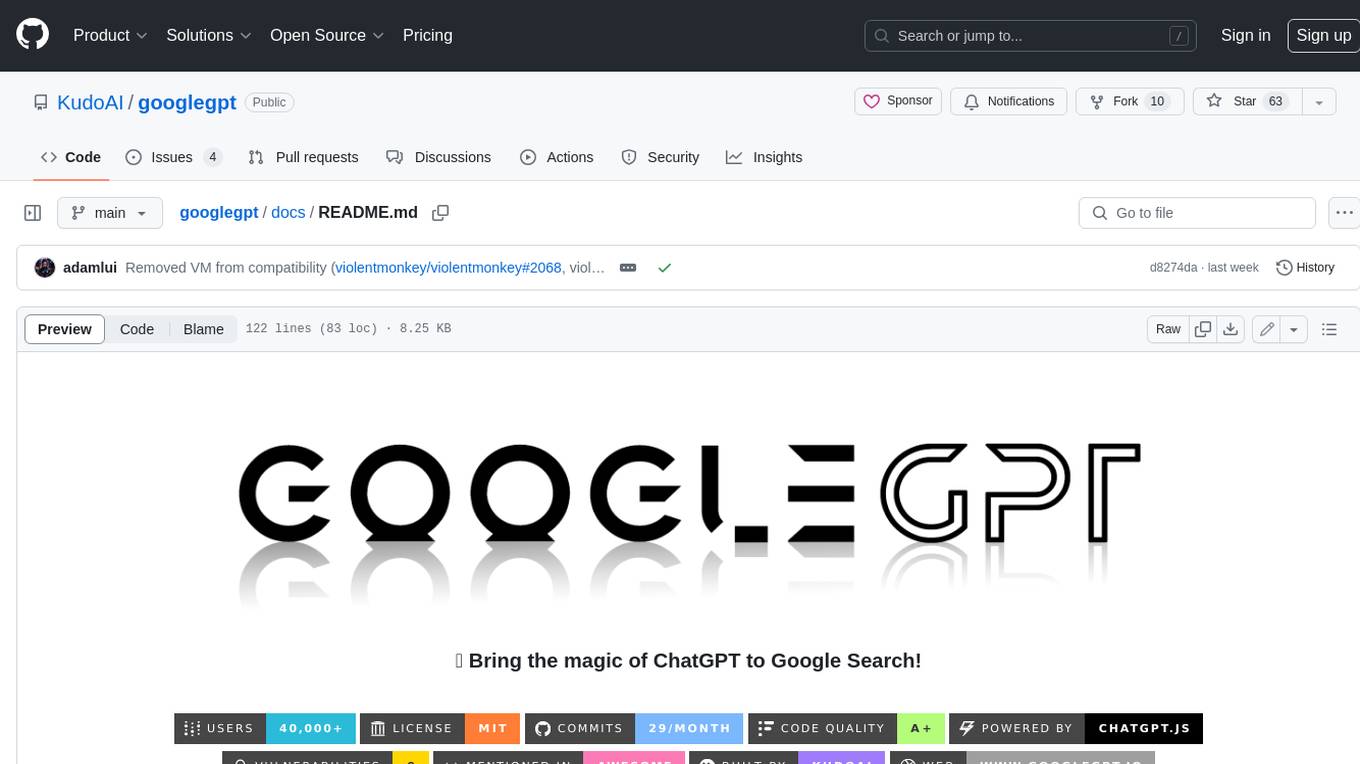
googlegpt
GoogleGPT is a browser extension that brings the power of ChatGPT to Google Search. With GoogleGPT, you can ask ChatGPT questions and get answers directly in your search results. You can also use GoogleGPT to generate text, translate languages, and more. GoogleGPT is compatible with all major browsers, including Chrome, Firefox, Edge, and Safari.
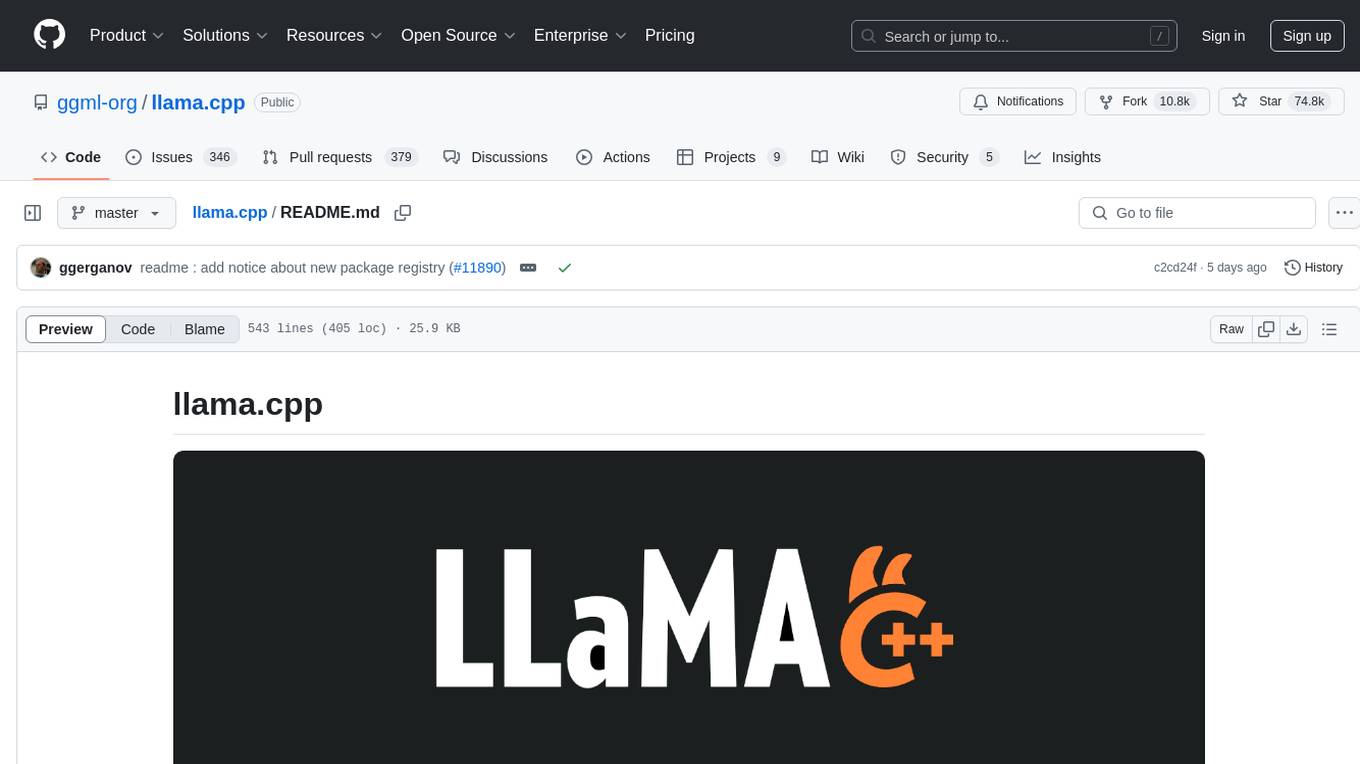
llama.cpp
The main goal of llama.cpp is to enable LLM inference with minimal setup and state-of-the-art performance on a wide range of hardware - locally and in the cloud. It provides a Plain C/C++ implementation without any dependencies, optimized for Apple silicon via ARM NEON, Accelerate and Metal frameworks, and supports various architectures like AVX, AVX2, AVX512, and AMX. It offers integer quantization for faster inference, custom CUDA kernels for NVIDIA GPUs, Vulkan and SYCL backend support, and CPU+GPU hybrid inference. llama.cpp is the main playground for developing new features for the ggml library, supporting various models and providing tools and infrastructure for LLM deployment.
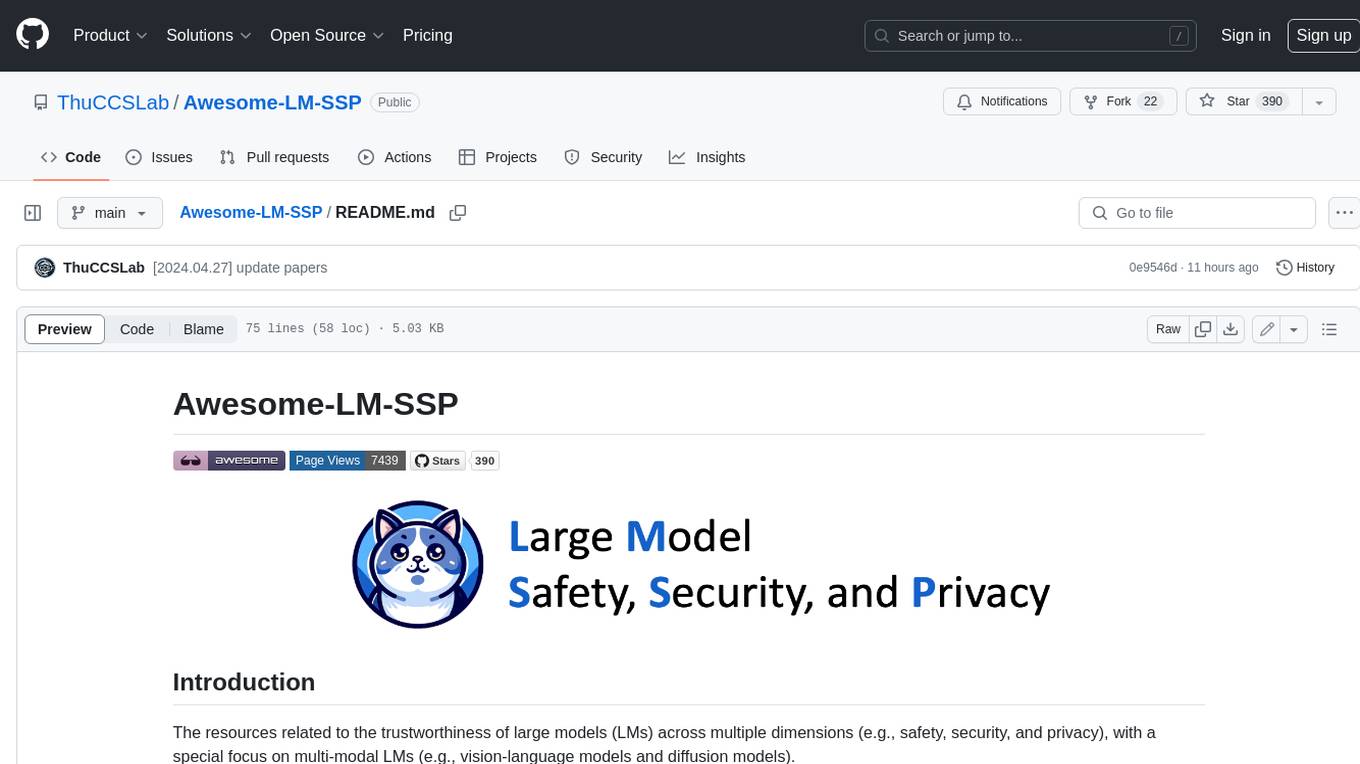
Awesome-LM-SSP
The Awesome-LM-SSP repository is a collection of resources related to the trustworthiness of large models (LMs) across multiple dimensions, with a special focus on multi-modal LMs. It includes papers, surveys, toolkits, competitions, and leaderboards. The resources are categorized into three main dimensions: safety, security, and privacy. Within each dimension, there are several subcategories. For example, the safety dimension includes subcategories such as jailbreak, alignment, deepfake, ethics, fairness, hallucination, prompt injection, and toxicity. The security dimension includes subcategories such as adversarial examples, poisoning, and system security. The privacy dimension includes subcategories such as contamination, copyright, data reconstruction, membership inference attacks, model extraction, privacy-preserving computation, and unlearning.
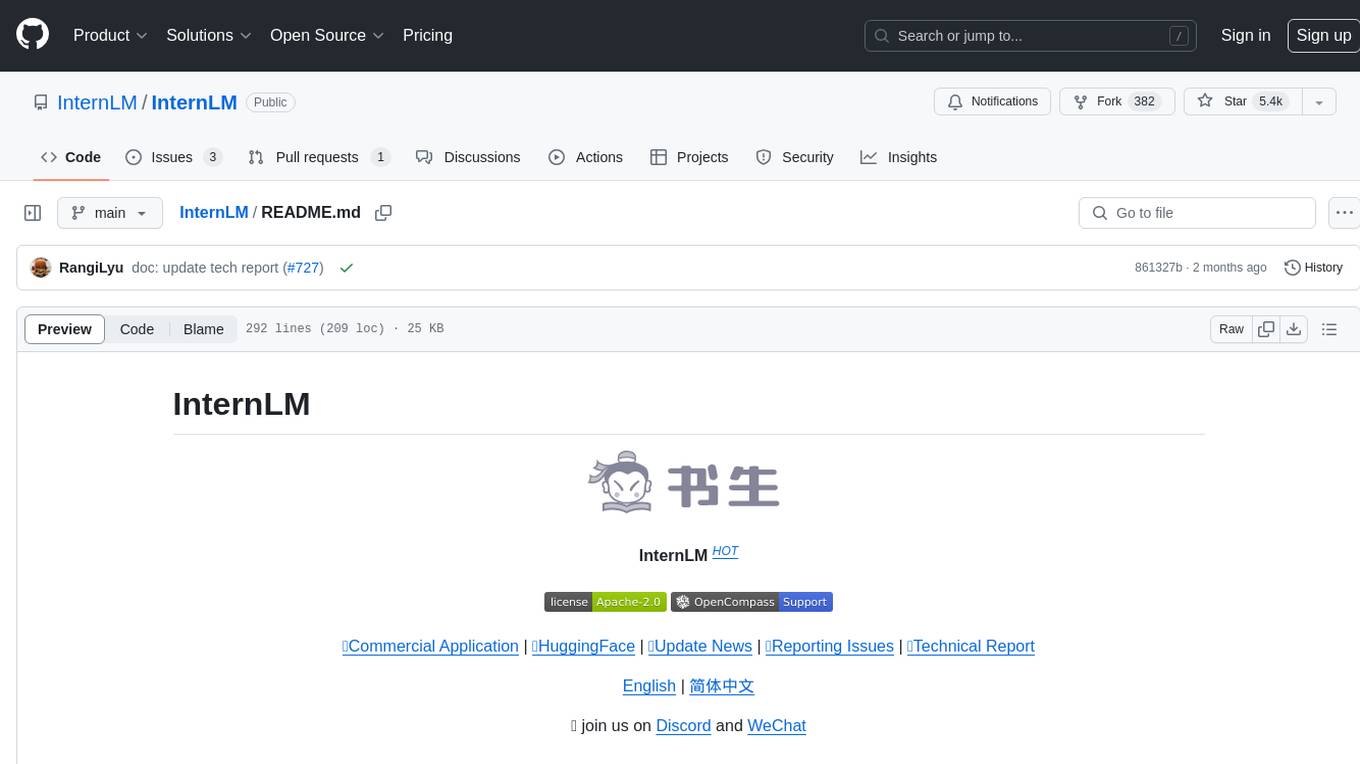
InternLM
InternLM is a powerful language model series with features such as 200K context window for long-context tasks, outstanding comprehensive performance in reasoning, math, code, chat experience, instruction following, and creative writing, code interpreter & data analysis capabilities, and stronger tool utilization capabilities. It offers models in sizes of 7B and 20B, suitable for research and complex scenarios. The models are recommended for various applications and exhibit better performance than previous generations. InternLM models may match or surpass other open-source models like ChatGPT. The tool has been evaluated on various datasets and has shown superior performance in multiple tasks. It requires Python >= 3.8, PyTorch >= 1.12.0, and Transformers >= 4.34 for usage. InternLM can be used for tasks like chat, agent applications, fine-tuning, deployment, and long-context inference.
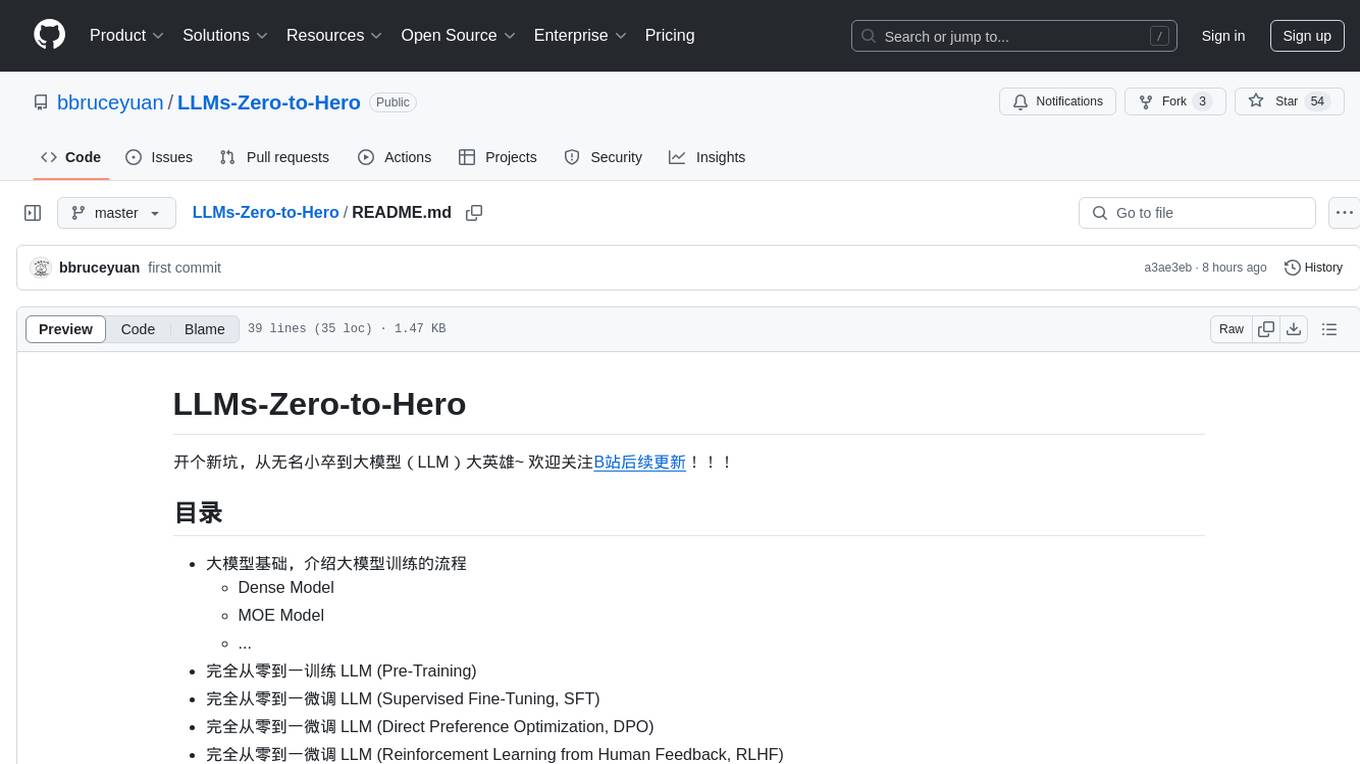
LLMs-Zero-to-Hero
LLMs-Zero-to-Hero is a repository dedicated to training large language models (LLMs) from scratch, covering topics such as dense models, MOE models, pre-training, supervised fine-tuning, direct preference optimization, reinforcement learning from human feedback, and deploying large models. The repository provides detailed learning notes for different chapters, code implementations, and resources for training and deploying LLMs. It aims to guide users from being beginners to proficient in building and deploying large language models.
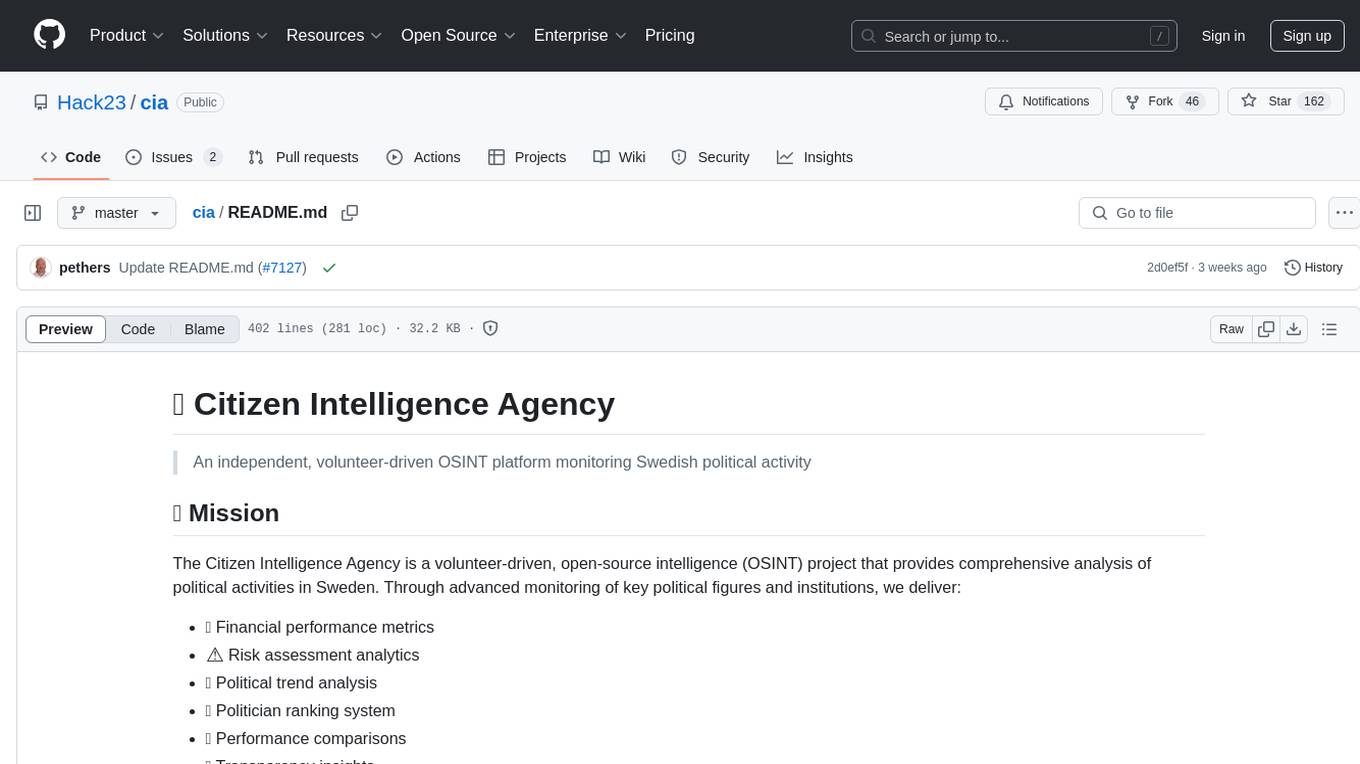
cia
CIA is a powerful open-source tool designed for data analysis and visualization. It provides a user-friendly interface for processing large datasets and generating insightful reports. With CIA, users can easily explore data, perform statistical analysis, and create interactive visualizations to communicate findings effectively. Whether you are a data scientist, analyst, or researcher, CIA offers a comprehensive set of features to streamline your data analysis workflow and uncover valuable insights.
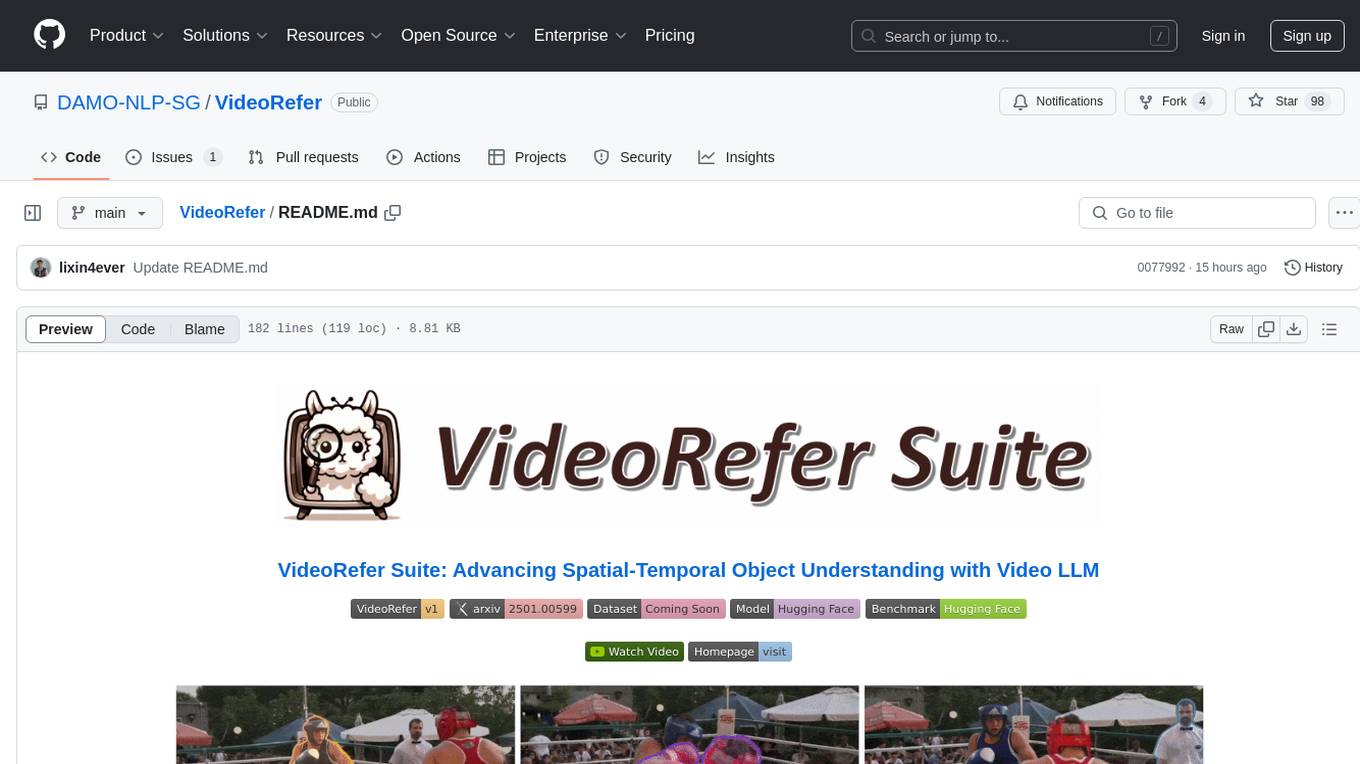
VideoRefer
VideoRefer Suite is a tool designed to enhance the fine-grained spatial-temporal understanding capabilities of Video Large Language Models (Video LLMs). It consists of three primary components: Model (VideoRefer) for perceiving, reasoning, and retrieval for user-defined regions at any specified timestamps, Dataset (VideoRefer-700K) for high-quality object-level video instruction data, and Benchmark (VideoRefer-Bench) to evaluate object-level video understanding capabilities. The tool can understand any object within a video.
For similar tasks
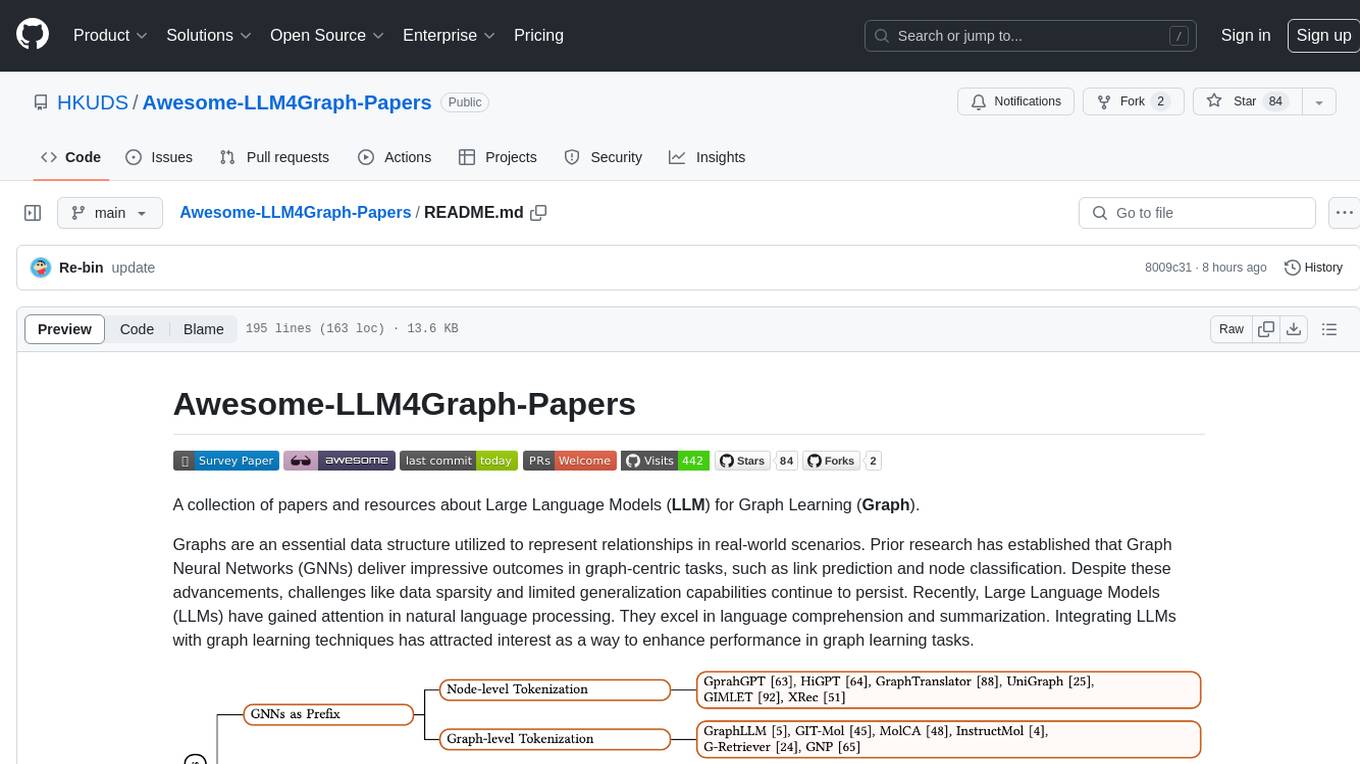
Awesome-LLM4Graph-Papers
A collection of papers and resources about Large Language Models (LLM) for Graph Learning (Graph). Integrating LLMs with graph learning techniques to enhance performance in graph learning tasks. Categorizes approaches based on four primary paradigms and nine secondary-level categories. Valuable for research or practice in self-supervised learning for recommendation systems.
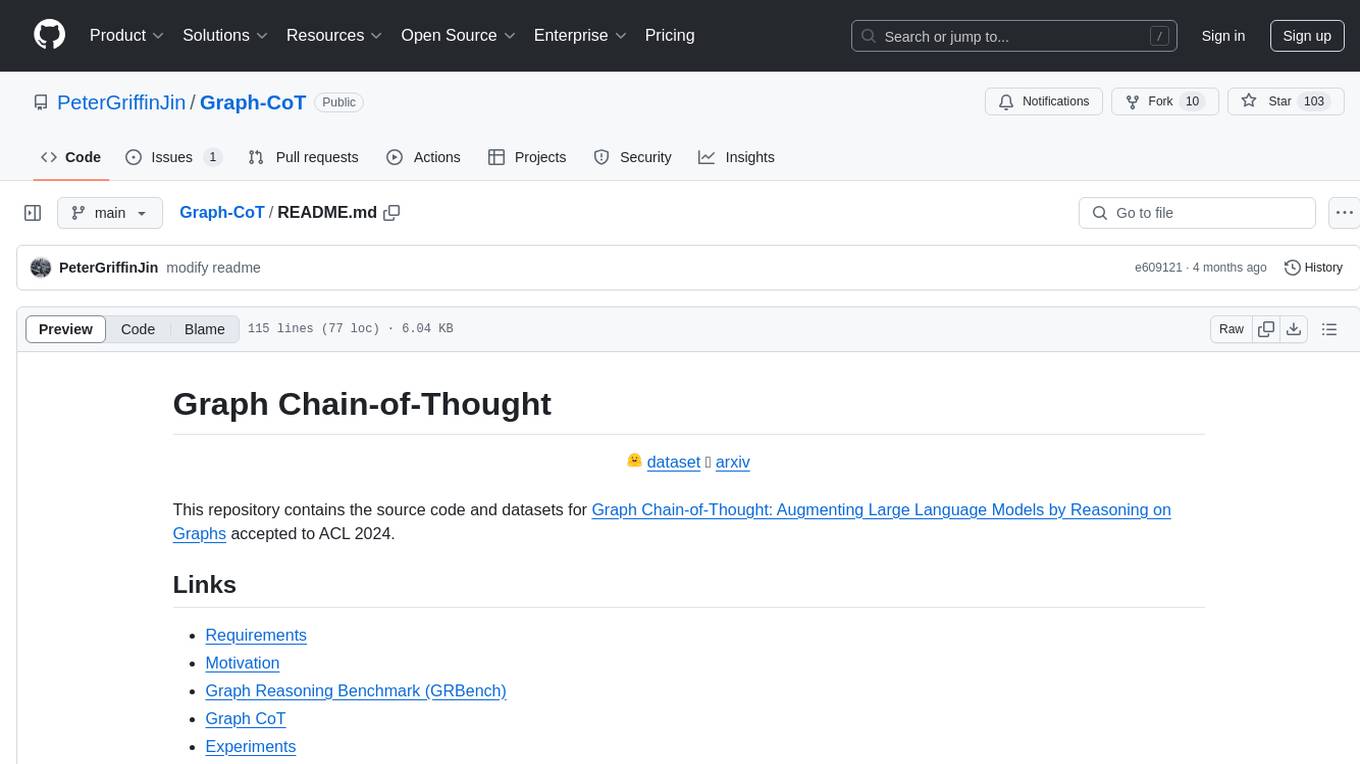
Graph-CoT
This repository contains the source code and datasets for Graph Chain-of-Thought: Augmenting Large Language Models by Reasoning on Graphs accepted to ACL 2024. It proposes a framework called Graph Chain-of-thought (Graph-CoT) to enable Language Models to traverse graphs step-by-step for reasoning, interaction, and execution. The motivation is to alleviate hallucination issues in Language Models by augmenting them with structured knowledge sources represented as graphs.

Awesome-Graph-LLM
Awesome-Graph-LLM is a curated collection of research papers exploring the intersection of graph-based techniques with Large Language Models (LLMs). The repository aims to bridge the gap between LLMs and graph structures prevalent in real-world applications by providing a comprehensive list of papers covering various aspects of graph reasoning, node classification, graph classification/regression, knowledge graphs, multimodal models, applications, and tools. It serves as a valuable resource for researchers and practitioners interested in leveraging LLMs for graph-related tasks.
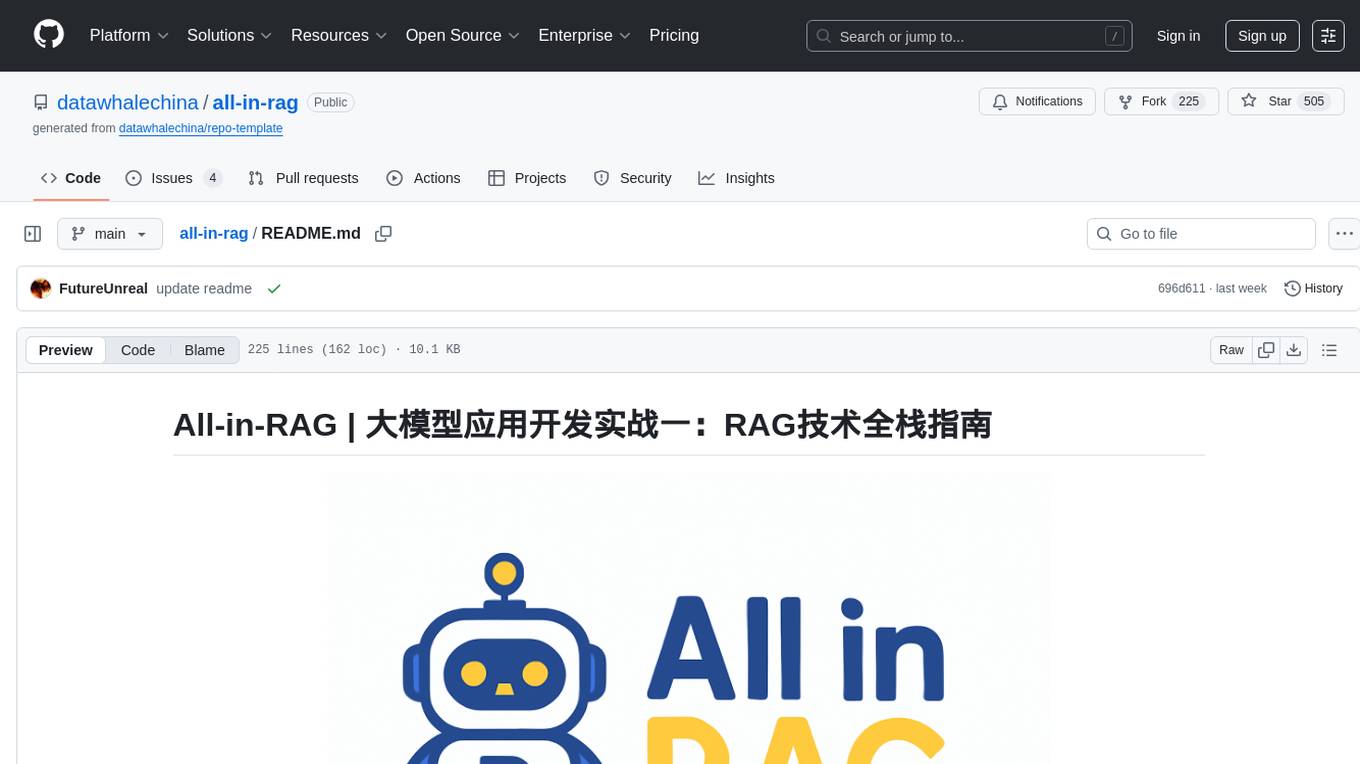
all-in-rag
All-in-RAG is a comprehensive repository for all things related to Randomized Algorithms and Graphs. It provides a wide range of resources, including implementations of various randomized algorithms, graph data structures, and visualization tools. The repository aims to serve as a one-stop solution for researchers, students, and enthusiasts interested in exploring the intersection of randomized algorithms and graph theory. Whether you are looking to study theoretical concepts, implement algorithms in practice, or visualize graph structures, All-in-RAG has got you covered.
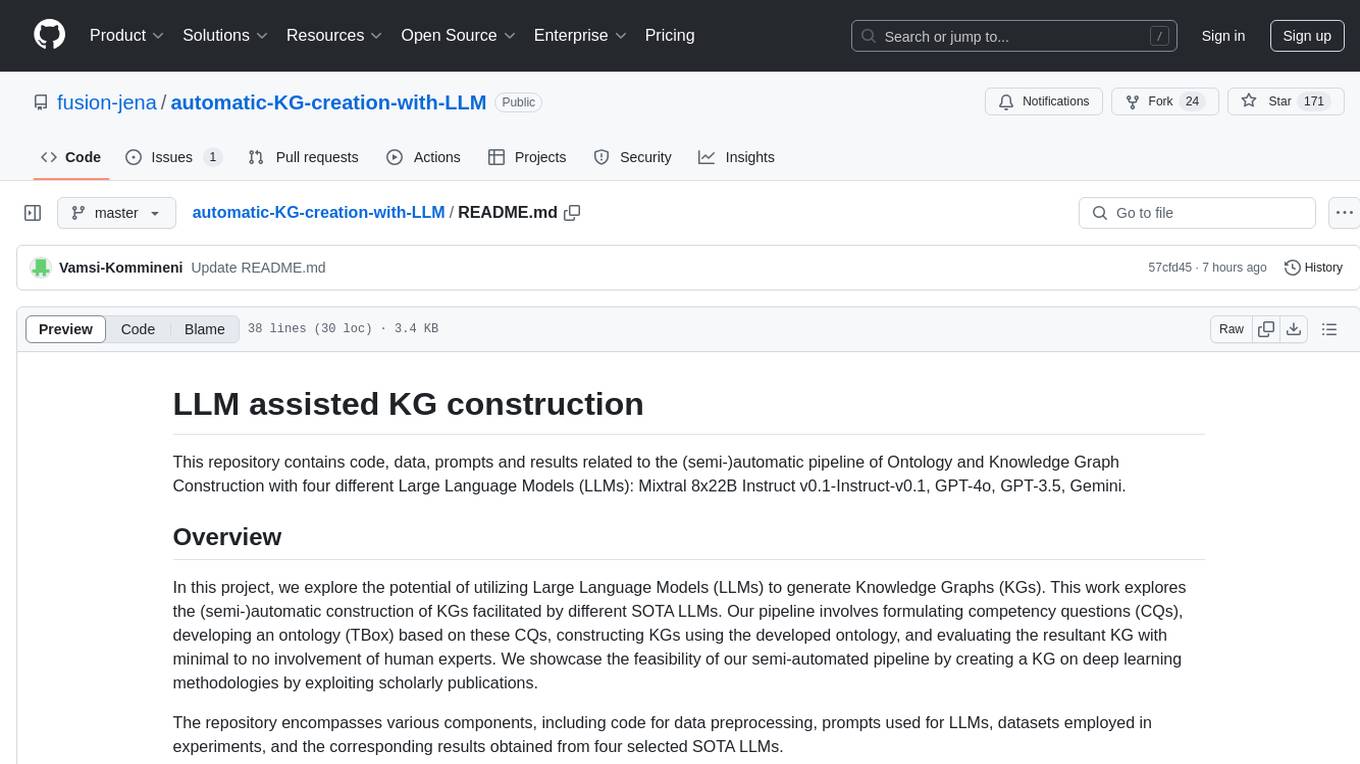
automatic-KG-creation-with-LLM
This repository presents a (semi-)automatic pipeline for Ontology and Knowledge Graph Construction using Large Language Models (LLMs) such as Mixtral 8x22B Instruct v0.1, GPT-4o, GPT-3.5, and Gemini. It explores the generation of Knowledge Graphs by formulating competency questions, developing ontologies, constructing KGs, and evaluating the results with minimal human involvement. The project showcases the creation of a KG on deep learning methodologies from scholarly publications. It includes components for data preprocessing, prompts for LLMs, datasets, and results from the selected LLMs.
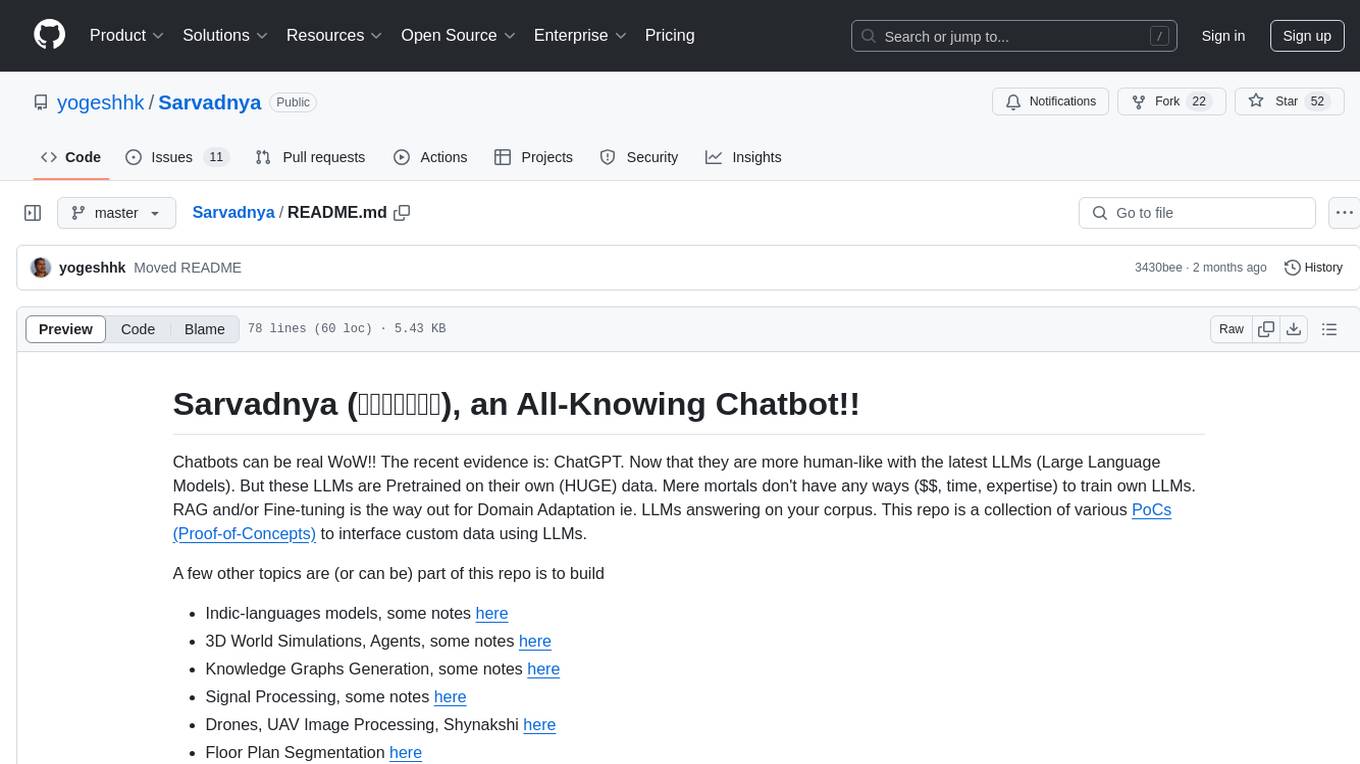
Sarvadnya
Sarvadnya is a repository focused on interfacing custom data using Large Language Models (LLMs) through Proof-of-Concepts (PoCs) like Retrieval Augmented Generation (RAG) and Fine-Tuning. It aims to enable domain adaptation for LLMs to answer on user-specific corpora. The repository also covers topics such as Indic-languages models, 3D World Simulations, Knowledge Graphs Generation, Signal Processing, Drones, UAV Image Processing, and Floor Plan Segmentation. It provides insights into building chatbots of various modalities, preparing videos, and creating content for different platforms like Medium, LinkedIn, and YouTube. The tech stacks involved range from enterprise solutions like Google Doc AI and Microsoft Azure Language AI Services to open-source tools like Langchain and HuggingFace.
For similar jobs

weave
Weave is a toolkit for developing Generative AI applications, built by Weights & Biases. With Weave, you can log and debug language model inputs, outputs, and traces; build rigorous, apples-to-apples evaluations for language model use cases; and organize all the information generated across the LLM workflow, from experimentation to evaluations to production. Weave aims to bring rigor, best-practices, and composability to the inherently experimental process of developing Generative AI software, without introducing cognitive overhead.

LLMStack
LLMStack is a no-code platform for building generative AI agents, workflows, and chatbots. It allows users to connect their own data, internal tools, and GPT-powered models without any coding experience. LLMStack can be deployed to the cloud or on-premise and can be accessed via HTTP API or triggered from Slack or Discord.

VisionCraft
The VisionCraft API is a free API for using over 100 different AI models. From images to sound.

kaito
Kaito is an operator that automates the AI/ML inference model deployment in a Kubernetes cluster. It manages large model files using container images, avoids tuning deployment parameters to fit GPU hardware by providing preset configurations, auto-provisions GPU nodes based on model requirements, and hosts large model images in the public Microsoft Container Registry (MCR) if the license allows. Using Kaito, the workflow of onboarding large AI inference models in Kubernetes is largely simplified.

PyRIT
PyRIT is an open access automation framework designed to empower security professionals and ML engineers to red team foundation models and their applications. It automates AI Red Teaming tasks to allow operators to focus on more complicated and time-consuming tasks and can also identify security harms such as misuse (e.g., malware generation, jailbreaking), and privacy harms (e.g., identity theft). The goal is to allow researchers to have a baseline of how well their model and entire inference pipeline is doing against different harm categories and to be able to compare that baseline to future iterations of their model. This allows them to have empirical data on how well their model is doing today, and detect any degradation of performance based on future improvements.

tabby
Tabby is a self-hosted AI coding assistant, offering an open-source and on-premises alternative to GitHub Copilot. It boasts several key features: * Self-contained, with no need for a DBMS or cloud service. * OpenAPI interface, easy to integrate with existing infrastructure (e.g Cloud IDE). * Supports consumer-grade GPUs.

spear
SPEAR (Simulator for Photorealistic Embodied AI Research) is a powerful tool for training embodied agents. It features 300 unique virtual indoor environments with 2,566 unique rooms and 17,234 unique objects that can be manipulated individually. Each environment is designed by a professional artist and features detailed geometry, photorealistic materials, and a unique floor plan and object layout. SPEAR is implemented as Unreal Engine assets and provides an OpenAI Gym interface for interacting with the environments via Python.

Magick
Magick is a groundbreaking visual AIDE (Artificial Intelligence Development Environment) for no-code data pipelines and multimodal agents. Magick can connect to other services and comes with nodes and templates well-suited for intelligent agents, chatbots, complex reasoning systems and realistic characters.














































































